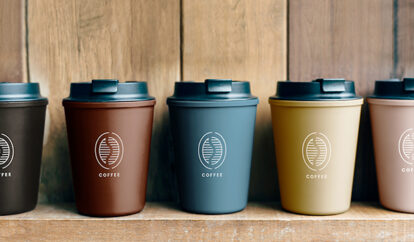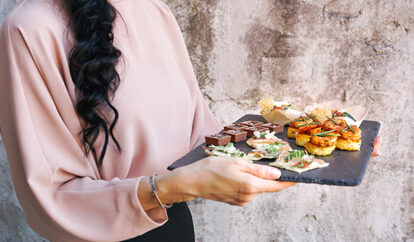Your visual brand is the first part of your restaurant that customers experience, even before your food. Logo, colors, imagery, etc. – your aesthetic – set the tone for your dining experience, help your customers connect with your food, and promote positive brand recognition.
As you develop a business plan and forecast sales, you should begin to develop your visual branding strategy as well. Having a plan will help ensure that your look remains cohesive as your brand expands. Otherwise, you’ll end up with a look that’s jumbled and inconsistent.
Your restaurant should develop a strong visual brand so you can:
- Stand out and stick in your customers’ minds
- Set the tone for the rest of your dining experience
- Form a connection between you and your customers
- Consistent marketing is easier marketing
Thanks to improvements in cloud-based template and design tools, there’s never been a better time to create or refresh your restaurant’s brand visual identity. Online design-it-yourself services allow small and mid-sized restaurants to create powerful, lasting brands.
These services provide smaller restaurants with the tools to design and promote their brand without breaking the bank. Some tools, like MustHaveMenus, are highly specialized for the restaurant and hospitality industry, including restaurant-savvy service teams that can help guide the process. Even the smallest restaurants can create a brand aesthetic that rivals the national chains.
Here are some guidelines to follow as you set out to create your visual brand strategy.
Know Your Identity
The food industry is crowded. Cookie-cutter brands get lost in the shuffle. Whenever you’re starting a brand from scratch or redesigning an old one, you need to take some time to brainstorm what sets you apart.
Initial Questions to Ask About Your Brand Visual Identity
First and foremost, how does your food set you apart? Is there an ethnic dimension to your food that helps create a deeper identity? Does your food distinguish you as a fine dining or casual dining atmosphere? What kind of experience do you want to create for your customers? What feelings do you want your restaurant to invoke?
Drilling down on these important questions will help establish your brand identity and guide your creative decisions. Here are some additional questions:
- Is there anything about your food that stands out?
- Are there any local landmarks to associate, including your building?
- Do you feature a certain type of entertainment?
- Is there something unique about your service style?
- Who is your ideal customer?
Your branding doesn’t need to be as unique as Route 66. It just needs to speak to something about your restaurant that will help customers remember you and establish brand recognition. Once you figure that out, you can start designing your look around it.
Create a Logo
A visual brand starts with your logo. It’s the part of your restaurant that’s wholly unique to you, and it serves as the launching point for the rest of your brand visuals. So the first step towards creating your visual brand is designing a logo.
Why are logos important?
- They serve as the first point of contact for your brand
- They act as a visual extension of your brand that reinforces recognition
- You can put them everywhere (menus, flyers, website, social, etc.)
- They set you apart from the competition
Logo Font – the simple approach
If for any reason a graphical logo mark seems too daunting – too expensive, too abstract – it’s always a strong option to simply use your restaurant name. All you have to do is find a font that captures your restaurant identity, then use it for your name everywhere you type it. Restaurant chains as large and successful as Outback Steakhouse and Chick Fil-A have used this strategy.
Logo Mark
Logo marks can be fun and memorable to your customers. It’s typical for the logo design to be tightly integrated and matched with your restaurant name. But it may have an additional use as a completely stand-alone representation of your restaurant. Think of the golden arches!
Things to consider for your logo:
- Are there any existing logos that have always jumped out to you? These can be great inspiration.
- How do you describe your restaurant when talking to friends and family? What words do you use? What feelings are you hoping to inspire?
- Who is your target audience?
- Do you have any existing visuals to work from? Images, color schemes, etc.
Once you have the logo, you can develop your menu design and all of your future marketing pieces with greater ease.
Design Like a Professional
The design of menus and marketing materials is a huge aspect of your branding. Oftentimes, it’s the first part of your brand that customers experience, and first impressions matter. Think of the world’s biggest brands, and certain symbols and colors immediately come to mind.
Until recently, a professionally-designed look across all of your materials was primarily the domain of the big budget restaurant chains who could afford design agencies or staff designers. For many years it was tough for smaller restaurants to justify the high cost of hiring a graphic designer to develop and maintain a visual brand.
Good news for the small guy! You no longer need to hire a graphic designer to get that designer look. Thanks to affordable and easy online design tools, every restaurant can now craft a brand aesthetic that’s unique and professional. For a fraction of what a graphic designer would cost, online design companies provide professional-caliber templates that you can customize to fit your restaurant.
Here are a few template and design resources for you to consider:
Be Consistent
Not only do online design tools help to craft your look, they enable you to replicate it across your various channels. This is important. Every time you reach a customer is an opportunity to grow or diminish your brand visual identity. In order to establish a strong one, you need consistency. Online design tools have vast libraries of templates to cover all your restaurant marketing materials. And they’re fast, so you’ll never need to use an off-brand design because you ran out of time!
Some of the most time-sensitive marketing channels for restaurants are social media sites like Facebook and Instagram. Most of the online design tools also offer social sharing tools to make this easy. With a few clicks, you can populate your timeline with fun, eye-catching content. Again, just make sure to be consistent with the rest of your brand’s look. Resizing an existing flyer, for example, may give you that matching look for a social post while saving a lot of work.
What are you waiting for?
A limited marketing budget is no longer an excuse to skimp your visual brand design. Get all the benefits of consistent, professional-looking designs that you see at the successful restaurants you’ve always admired. Your customers will reward you by coming back for more!





